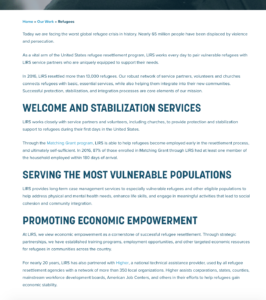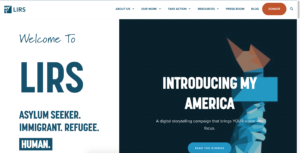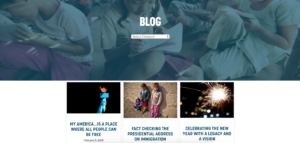Mark Perry, Will Johnston, Joe Candon
Almost anyone can tell you what the American Dream means to them. But can anyone obtain this dream? We propose that now a days the American Dream is unrealistic for immigrants. The way American society and government are makes it more difficult for immigrants. Immigrant families are being separated from one another once entering America and are not given a fair chance at reaching their goals.
The inspiration came from the novel Americanah and the current news on immigration. Our goal is to create an experience similar to Americanahs chapter 9 when Ifemelu’s comes to America for the first time. Ifemelu arrives in America and Aunty Ujupicks her up from the airport in New York. Uju seems tense and unhappy, different from how Ifemelu remembers her. Ifemelu also relizes that when speaking on the phone Uju pronounces her name differently because that’s what people call her here in America. Ifemelu has to sleep on the floor, as Aunty Ujuand Dike share the single bed. Ifemelu expected everything to be more glamorous than it is, and she can’t fall asleep, overcome by the newness of it all. She looks out the window and notices how different the street looks from the one on The Cosby Show (Adichie).Everything since her arrival seems disappointing and even unfriendly to Ifemelu, and Aunty Uju provides an example of how the pressures of immigrant life can “subdue” and change someone (Adichie).
LATimesjournalist Angelica Quintero wrote anarticle titled America’s love-hate relationship with immigrants.This article is about how even though America is made up of immigrants it has a history of having problems with immigration. The articles stated “The poor, the sick and those espousing certain political beliefs were barred from entry into the U.S. under other new laws. Laws discouraging immigration from Southern Europe — mainly from Italy — reflected widespread anti-Catholic sentiment (Quintero).” This article also stated “President Trump ordered an overhaul of immigration law enforcement, stripping away most restrictions on who should be deported. Under the new guidelines, up to 8 million people in the country illegally could be targeted for deportation (Quintero).”
We chose to use Twine to create out choose your own adventure game. The experience we are trying to create is an adventure game where the user/ player is an immigrant entering America and what you go through once in the “Dream Land.” We want to impact your experience as an immigrant to create a unique and memorable experience. Our users will make their own choices and each choice will have a different or similar outcome. This will put the user in an immigrant’s shoes and bring out different emotions ones you wouldn’t get from just watching T.V or reading.
Our story begins right after the user gets picked up from the airport and includes the journey to their aunt’s house. To navigate the simulation the user will read the text at each step and then click on the links at the bottom. Once the user reaches the end of the simulation they will have the opportunity to go through it again and make different choices the second time through.
Sources
Cherry, Stephen M. and Lucas, Amy. “The immigrant experience: Houstonians’ family attitudes and behaviors.” Sociological Spectrum, vol. 36, no. 6, 2016, pp. 378-390.
-This is a scholarly article about the view of family between America and immigrants coming to America and how they’re different. The article goes into depth about assimilation, socialization, intermarriage, and family attitudes. Using the Houston Area Survey, a 2011 study concluded that non-Houston citizens are more likely to date members of a different ethnic race making it very likely for Houston to become diverse in the coming years. The survey also states that immigrants exposed to American culture and attitudes are more likely to portray the same attitudes and culture they see assimilating to what’s around them. The last part of the article states that immigrants are paid less than minimum wage on average. The article helps us blend the world of Americanah with contemporary America. This article gives us a wider look at immigration in America and can therefore use the information done in the survey to help make sense of how the Aunt and main character (you) fit into our world logically. This piece was used as a way to create the household in which the Aunt lives in and takes the main character (you) to at the end of play.
Helsel, Phil and Fichtel, Caitlin. “University of North Carolina at Charlotte shooting kills 2, injures 4.” NBC News, https://www.nbcnews.com/news/us-ne ws/least-2-dead-2-injured-after-report-shooting-university-north-n1000436.
–This is a NBC News article about the school shooting at the University of North Carolina. A 22-year man is charged with the murder of two University of North Carolina students and the attempted murder of four others. Three of the four are in critical condition. The shooting happened on the last day of the school year at the University of North Carolina. The incident was viewed as a “tragic loss to a great university,” and “time for mourning.” With the main character (you) entering America, having left a country (Nigeria) with lots of violence and political corruption going on, going to a place looking for the “American Dream” means that violence should be minimal to non-existent. This article goes against that idea of a “dream” world and creates fear. This piece is used as a news piece to make the main character (you) feel uneasy about coming to America. With the main character coming to America with high hopes of the American Dream, this helps shift their personal thoughts towards viewing America in a less pretty light and send our choose your own adventure into the second part.
Ibrahim, Awad. “Don’t Call Me Black! Rhizomatic Analysis of Blackness, Immigration, and the Politics of Race Without Guarantees.” Educational Studies, vol. 53, no. 5, 2017, pp. 511-521.
-This is a scholarly article about African American immigration to America. Three studies researching how African Americans are perceived in literature create a framework on how black immigrants think, learn, and create their desires and identities. African American immigrants are said to have a disadvantage before even coming to America with literature having already written out their story so they have farther to go before they can truly get anywhere. A new narrative needs to be taught so African Americans can create their own stories. This piece was used to help in the overall creation of what the main character (you) experience when coming to America. With this project being a five minute simulation of the American experience from the viewpoint of an immigrant, the story is set up so the main character has the chance to make their own narrative and create their own narrative. With the create your own story aspect, there’s multiple possible ways that people playing as the main character can see different horrors of the world to influence the main character’s thoughts changing about the American Dream, and then getting to create their own story (if this project were to be flushed out into something bigger).
Li, David K. and Madani, Doha. “Minneapolis police officer found guilty in shooting death of unarmed woman who called 911.” NBC News, https://www. nbcnews.com/news/us-news/minneapolis-police-officer-found-guilty-shooting -death-unarmed-woman-who-n999706.
-This is an article from NBC news about a police officer shooting an unarmed woman in Minnesota. The woman called the police reporting a sexual assault happening next door. When the officer arrived on the scene, she ran up to the police car and was shot. The officer is pleading not guilty with evidence being the only thing that is holding up the court hearing. This piece was used as a news piece heard in the game to make the main character uneasy about their safety in America and the police officers meant to protect them. With the American Dream on the main character (you)’s mind, and entering a city where police activity is heavy in certain parts (North Philadelphia), this article creates fear. The main character is in another city but after hearing this can start feeling uneasy due to the fact that they may fear if this incident were to happen to them. Entering a country at a time where tensions are constantly high between law officials and the African American community makes the situation more fearful for the audience playing as the main character.
Maxouris, Christina and Sutton, Joe. “A 25-year-old Iowa woman was shot and killed while driving home from work.” CNN, https://www.cnn.com/2019/04/30/ us/iowa-former-student-shot-and-killed-highwy/index.html.
–This is an article from CNN about a student who was shot and killed driving home from work. The woman was shot in the neck at around 2:30 am. The police have no information on the killer at the time, and are offering a $7,000 reward for anyone who comes forward with information on the killer. This piece was used as a news piece heard in the game to make the main character uneasy about their safety in America. This article goes against the idea of the “American Dream” creating fear in the main character (you). With the main character riing home at the moment of hearing the article, this creates not just general fear now while driving home but any time when going around in America. The main character left the violence of back home only to enter a new world of violence that really isn’t all that different. It just has a difference mask it wears. Using a real world article also makes it more realistic for the person playing this simulation because they can take from stuff they either know or may hear of.
Nwanyanwu, Augustine Uka. “Transculturalism, Otherness, Exile, and Identity in Chimamanda Ngozi Adichie’s Americanah.” Brill, vol. 49, 2017, pp. 386-399.
-The literary analysis really helped us dive into the themes in which Chimamando Ngozi Adichie explores in her novel Americanah. We specifically looked at the theme of transculturalism. We explored this theme through the aunt’s adjustment to America. These aspects are pointed out as the main character is seeing everything with brand new eyes. When the aunt talks about the music and how the main character needs to get used to it because it is all around. The same happened when the main character sees the police officers. It helped us understand the relationship between Ifemelu and Aunt Uju. We tried to adapt a similar relationship between the main character and the aunt in our story. It often showed up in the responses from the main character to the aunt as well as the responses the aunt must the main character when they react to the radio or something seen out the window. At the end of the story we also try to touch on the theme of identity. As the main character is in the aunt’s house they realize that the American dream is not all that it is made up to be. It is seen that the aunt is struggling and in a lesser spot than if she had stayed in Nigeria. This prompts the main character to question if the right choice was made in coming to the United Statea.
Quintero, Angelica. “America’s Love-Hate Relationship with Immigrants.” Los Angeles Times, www.latimes.com/projects/la-na-immigration-trends/.
-This is a Los Angeles Times article about America’s love/hate relationship with immigrants. The article compares how America current handles immigration now versus in the past. A lot of polls and research went into the article. Many show the spike in immigration happening in the late 80s, early 90s, and beyond. But over time, more immigration executions have been ordered and a push has gone to create a wall preventing immigrants from coming into America. The article also has many political articles that exaggerate for humor the United States’ stance on immigrants coming in with one comic in particular standing out to me where a man wearing a United States hat is standing in a brick box me made for himself to keep out Refugees, Muslims, and Mexicans. But even with that much protection, the man states he still feels “unsafe” and should make a “lid” to be fully enclosed. This piece was used to help create the love/hate relationship the main character (you) have when seeing America for the first time. It can be seen in the situation for housing that the main character goes into because of the crappy situation her aunt is in due to being an immigrant and having a tough start in getting her “American Dream” going.






